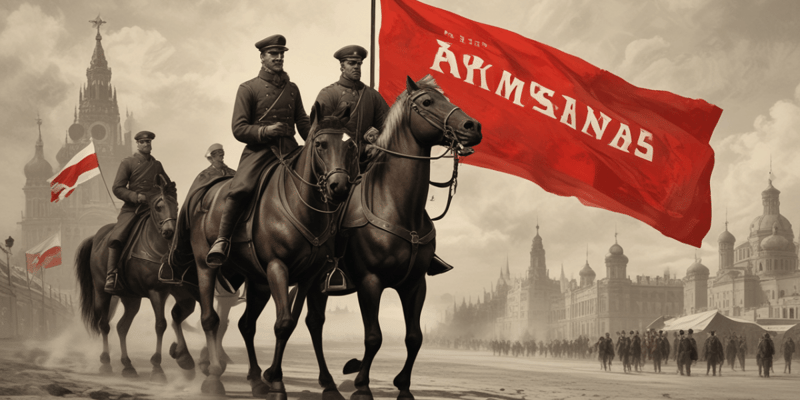Podcast
Questions and Answers
Who governed the Soviet Union as a one-party state before the fall of communism?
Who governed the Soviet Union as a one-party state before the fall of communism?
What new political system was established in Russia after the fall of communism?
What new political system was established in Russia after the fall of communism?
What ideology was the Soviet system based on?
What ideology was the Soviet system based on?
Which individual rights and freedoms were protected by Russia's new constitution adopted in 1993?
Which individual rights and freedoms were protected by Russia's new constitution adopted in 1993?
Signup and view all the answers
Who introduced reforms aimed at modernizing the Soviet system in the late 1980s?
Who introduced reforms aimed at modernizing the Soviet system in the late 1980s?
Signup and view all the answers
Who succeeded Yeltsin as the president of Russia in 1999?
Who succeeded Yeltsin as the president of Russia in 1999?
Signup and view all the answers
Which opposition movement was led by Boris Yeltsin in response to Gorbachev's reforms?
Which opposition movement was led by Boris Yeltsin in response to Gorbachev's reforms?
Signup and view all the answers
What has characterized Russia's political landscape since the fall of communism?
What has characterized Russia's political landscape since the fall of communism?
Signup and view all the answers
In 1989, who was elected as the first popularly-elected president of the Russian Soviet Federative Socialist Republic?
In 1989, who was elected as the first popularly-elected president of the Russian Soviet Federative Socialist Republic?
Signup and view all the answers
What did the economic transition from a planned to a market economy result in for many Russians?
What did the economic transition from a planned to a market economy result in for many Russians?
Signup and view all the answers
What event marked the beginning of a new era for Russia after the fall of communism?
What event marked the beginning of a new era for Russia after the fall of communism?
Signup and view all the answers
What is a notable characteristic of Putin's rule in Russia?
What is a notable characteristic of Putin's rule in Russia?
Signup and view all the answers
Study Notes
Fall of Communism and Rebirth of Russia
The fall of communism in Russia marked the end of the Soviet Union and the beginning of a new era for the country. This period was characterized by significant political, economic, and social changes that continue to shape modern Russia.
The Soviet System
Before the fall of communism, the Soviet Union was a one-party state governed by the Communist Party of the Soviet Union (CPSU). The Communist Party controlled all aspects of society, including the economy, education, and media. The Soviet system was based on the ideas of Marxism-Leninism, which aimed to create a classless society through collective ownership of the means of production.
The Fall of Communism
The fall of communism in Russia began in the late 1980s with the policies of Soviet leader Mikhail Gorbachev. Gorbachev introduced reforms aimed at modernizing the Soviet system and improving the lives of its citizens. However, these reforms also led to increased political freedoms and the rise of opposition movements.
One of the most significant opposition movements was the National Front of the Reforms, led by Boris Yeltsin. Yeltsin was a former Communist Party member who became a leading figure in the democratic opposition. In 1989, Yeltsin was elected as the first popularly-elected president of the Russian Soviet Federative Socialist Republic (RSFSR), one of the constituent republics of the Soviet Union.
The Rebirth of Russia
The fall of communism in Russia led to the establishment of a new political system based on democracy and the rule of law. Russia's new constitution, adopted in 1993, established the separation of powers and protected individual rights and freedoms.
The economic transition from a planned to a market economy was challenging and resulted in economic hardship for many Russians. However, it also led to the emergence of new businesses and entrepreneurs, contributing to economic growth.
Russia's political landscape has been characterized by a mix of continuity and change since the fall of communism. Yeltsin served as president until 1999, when he was succeeded by Vladimir Putin. Putin has been in power ever since, first as president and then as prime minister (2008-2012) and again as president since 2012. Putin's rule has been marked by increased centralization of power and a more authoritarian style of governance.
Conclusion
The fall of communism in Russia led to the rebirth of the country as a democratic and market-oriented state. While this transition was challenging, it also provided the foundation for Russia's modern political and economic systems. Today, Russia continues to grapple with the legacy of communism and the ongoing challenges of modernization and democratic development.
Studying That Suits You
Use AI to generate personalized quizzes and flashcards to suit your learning preferences.
Description
Test your knowledge about the fall of communism in Russia, the establishment of a democratic political system, and the economic transition during the rebirth of the country. Explore key events, figures, and the impact of these changes on modern Russia.




